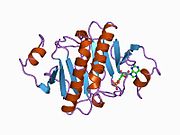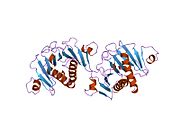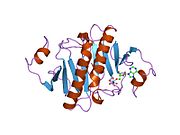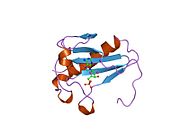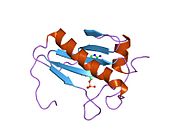HINT1
An Error has occurred retrieving Wikidata item for infobox Histidine triad nucleotide-binding protein 1 also known as adenosine 5'-monophosphoramidase is an enzyme that in humans is encoded by the HINT1 gene.[1][2]
HINT1 hydrolyzes purine nucleotide phosphoramidates with a single phosphate group.[3] In addition, functions as scaffolding protein that modulates transcriptional activation.[4]
It is a haploinsufficient tumor suppressor gene that inhibits the Wnt/β-catenin pathway in colon cancer cells and microphthalmia-associated transcription factor (MITF) activity in human mast cells.[5][6] In the LysRS-Ap4A-MITF signaling pathway, HINT1 inhibits the MITF transcriptional activity by direct association. Upon pathway activation, HINT1 is released from MITF by diadenosine tetraphosphate (Ap4A), produced by LysRS.[6][7]
See also
References
- ^ Brzoska PM, Chen H, Levin NA, Kuo WL, Collins C, Fu KK, Gray JW, Christman MF (Feb 1997). "Cloning, mapping, and in vivo localization of a human member of the PKCI-1 protein family (PRKCNH1)". Genomics. 36 (1): 151–6. doi:10.1006/geno.1996.0435. PMID 8812426.
- ^ "Entrez Gene: HINT1 histidine triad nucleotide binding protein 1".
- ^ Strom A, Tong CL, Wagner CR (May 2020). "Histidine triad nucleotide-binding proteins HINT1 and HINT2 share similar substrate specificities and little affinity for the signaling dinucleotide Ap4A". FEBS Letters. 594 (10): 1497–1505. doi:10.1002/1873-3468.13745. PMID 31990367. S2CID 210933742.
- ^ "P49773: HINT1 (human)". UniProt.
- ^ Wang L, Li H, Zhang Y, Santella RM, Weinstein IB (Apr 2009). "HINT1 inhibits beta-catenin/TCF4, USF2 and NFkappaB activity in human hepatoma cells". Int J Cancer. 124 (7): 1526–34. doi:10.1002/ijc.24072. PMC 2667231. PMID 19089909.
- ^ a b Lee YN, Nechushtan H, Figov N, Razin E (Feb 2004). "The function of lysyl-tRNA synthetase and Ap4A as signaling regulators of MITF activity in FcepsilonRI-activated mast cells". Immunity. 20 (2): 145–51. doi:10.1016/S1074-7613(04)00020-2. PMID 14975237.
- ^ Yannay-Cohen N, Carmi-Levy I, Kay G, Yang CM, Han JM, Kemeny DM, Kim S, Nechushtan H, Razin E (June 2009). "LysRS serves as a key signaling molecule in the immune response by regulating gene expression". Mol Cell. 34 (5): 603–11. doi:10.1016/j.molcel.2009.05.019. PMID 19524539.
Further reading
- Brzoska PM, Chen H, Zhu Y, et al. (1995). "The product of the ataxia-telangiectasia group D complementing gene, ATDC, interacts with a protein kinase C substrate and inhibitor". Proc. Natl. Acad. Sci. U.S.A. 92 (17): 7824–8. Bibcode:1995PNAS...92.7824B. doi:10.1073/pnas.92.17.7824. PMC 41238. PMID 7644499.
- Lima CD, Klein MG, Weinstein IB, Hendrickson WA (1996). "Three-dimensional structure of human protein kinase C interacting protein 1, a member of the HIT family of proteins". Proc. Natl. Acad. Sci. U.S.A. 93 (11): 5357–62. Bibcode:1996PNAS...93.5357L. doi:10.1073/pnas.93.11.5357. PMC 39250. PMID 8643579.
- Lima CD, Klein MG, Hendrickson WA (1997). "Structure-based analysis of catalysis and substrate definition in the HIT protein family". Science. 278 (5336): 286–90. doi:10.1126/science.278.5336.286. PMID 9323207.
- Klein MG, Yao Y, Slosberg ED, et al. (1998). "Characterization of PKCI and comparative studies with FHIT, related members of the HIT protein family". Exp. Cell Res. 244 (1): 26–32. doi:10.1006/excr.1998.4153. PMID 9770345.
- Weitzdoerfer R, Stolzlechner D, Dierssen M, et al. (2002). "Reduction of nucleoside diphosphate kinase B, Rab GDP-dissociation inhibitor beta and histidine triad nucleotide-binding protein in fetal Down syndrome brain". J. Neural Transm. Suppl. (61): 347–59. doi:10.1007/978-3-7091-6262-0_29. ISBN 978-3-211-83704-7. PMID 11771757.
- Bieganowski P, Garrison PN, Hodawadekar SC, et al. (2002). "Adenosine monophosphoramidase activity of Hint and Hnt1 supports function of Kin28, Ccl1, and Tfb3". J. Biol. Chem. 277 (13): 10852–60. doi:10.1074/jbc.M111480200. PMC 2556056. PMID 11805111.
- Brenner C (2002). "Hint, Fhit, and GalT: function, structure, evolution, and mechanism of three branches of the histidine triad superfamily of nucleotide hydrolases and transferases". Biochemistry. 41 (29): 9003–14. doi:10.1021/bi025942q. PMC 2571077. PMID 12119013.
- Strausberg RL, Feingold EA, Grouse LH, et al. (2003). "Generation and initial analysis of more than 15,000 full-length human and mouse cDNA sequences". Proc. Natl. Acad. Sci. U.S.A. 99 (26): 16899–903. Bibcode:2002PNAS...9916899M. doi:10.1073/pnas.242603899. PMC 139241. PMID 12477932.
- Gevaert K, Goethals M, Martens L, et al. (2004). "Exploring proteomes and analyzing protein processing by mass spectrometric identification of sorted N-terminal peptides". Nat. Biotechnol. 21 (5): 566–9. doi:10.1038/nbt810. PMID 12665801. S2CID 23783563.
- Galey D, Becker K, Haughey N, et al. (2003). "Differential transcriptional regulation by human immunodeficiency virus type 1 and gp120 in human astrocytes". J. Neurovirol. 9 (3): 358–71. doi:10.1080/13550280390201119. PMID 12775419. S2CID 22016092.
- Ota T, Suzuki Y, Nishikawa T, et al. (2004). "Complete sequencing and characterization of 21,243 full-length human cDNAs". Nat. Genet. 36 (1): 40–5. doi:10.1038/ng1285. PMID 14702039.
- Gerhard DS, Wagner L, Feingold EA, et al. (2004). "The status, quality, and expansion of the NIH full-length cDNA project: the Mammalian Gene Collection (MGC)". Genome Res. 14 (10B): 2121–7. doi:10.1101/gr.2596504. PMC 528928. PMID 15489334.
- Weiske J, Huber O (2006). "The histidine triad protein Hint1 triggers apoptosis independent of its enzymatic activity". J. Biol. Chem. 281 (37): 27356–66. doi:10.1074/jbc.M513452200. PMID 16835243.
- Ajit SK, Ramineni S, Edris W, et al. (2007). "RGSZ1 interacts with protein kinase C interacting protein PKCI-1 and modulates mu opioid receptor signaling". Cell. Signal. 19 (4): 723–30. doi:10.1016/j.cellsig.2006.09.008. PMID 17126529.
- Symes AJ, Eilertsen M, Millar M, et al. (2013). "Quantitative Analysis of BTF3, HINT1, NDRG1 and ODC1 Protein Over-Expression in Human Prostate Cancer Tissue". PLOS ONE. 8 (12): e84295. Bibcode:2013PLoSO...884295S. doi:10.1371/journal.pone.0084295. PMC 3874000. PMID 24386364.
